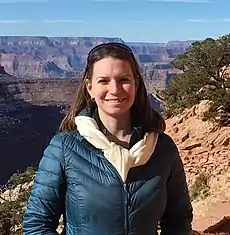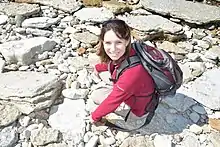Alycia Stigall
Alycia L. Stigall is an American palaeontologist. As a professor at Ohio University, she was the first to analyze the biogeographic ranges of Paleozoic fossils using Geographic information systems.
Alycia Stigall | |
|---|---|
 Stigall in 2019 | |
| Born | |
| Spouse(s) | Daniel Hembree (m. 2006) |
| Academic background | |
| Education | B.S., Biology and Geological Sciences, 1999, Ohio State University M.S., 2001, PhD, 2004, University of Kansas |
| Academic work | |
| Institutions | Ohio University |
Early life and education
Stigall was born and raised in Colerain Township, Hamilton County, Ohio to parents Jackie and Joe Stigall.[1] Growing up, she spent time collecting brachiopods and bryozoans from a nearby creek and went camping in various National Parks across the country.[2] Stigall attended Colerain High School where she was a National Merit Finalist and member of the National Honor Society, Marching Band, Collage, Show Choir, and German Club. Prior to graduating, she earned a full academic scholarship to Ohio State University.[3]
Upon earning a Bachelor of Science degree from Ohio State University in 1995, she was named the top science graduate in the country and received the only Grinnell Fellowship at the University of Kansas. Similarly, she also earned a science foundation grant for $15,000 per year for the next four years for graduate-level studies.[1]
Career
Upon receiving her PhD, Stigall joined the faculty at Ohio University as an associate professor of geological sciences. In this role, she published a study suggesting that the planet’s current ecosystem, which is struggling with biodiversity loss, could lead to a similar collapse of Earth’s marine as happened 378 to 375 million years ago.[4] This led her to become the first to analyze the biogeographic ranges of Paleozoic fossils using Geographic information systems.[5] She also published an article in Palaeontology arguing for a broader evolutionary theory that accounts for large-scale environmental changes such as plate tectonics, sea level changes and climate change over periods measured by tens of thousands of years.[6]
Stigall was inspired by the book, A Golden Guide to Fossils, which she read in her youth, to develop an updated, comprehensive online database titled the Digital Atlas of Ordovician Life.[7] She also co-developed an online free app called "Digital Atlas of Ancient Life" which aimed to be a tool for "exploring and identifying marine fossils from three different regions and time periods."[8] In 2016, Stigall was the recipient of the Charles Schuchert Award from the Paleontological Society given in recognition of a paleontologist under the age of 40. She was recognized for her "contributions to the understanding of the impact of species invasion on species and ecosystems within shallow marine communities during the Ordovician Period and the Late Devonian Mass Extinction."[9] She was also acknowledged by the Association for Women Geoscientists with their Professional Excellence Award in the academia and research category.[10]

As a Full professor, Stigall and her research team, consisting of Nancy Stevens and Y. Ranjeev Epa, analyzed snail fossils from 24 to 26 million years ago and identified six new species. Their study provided the first documentation of rapid evolutionary diversification in freshwater invertebrates associated with the development of rifting in the East African Rift Zone.[11] She similarly found that The Great Biodiversification Event, in which new species developed rapidly, actually occurred during the Darriwilian Stage about 465 million years ago.[12]
In 2020, Stigall collaborated with an international team to co-publish The Devonian-Cretaceous fossil record of ‘conchostracans’ of Africa and their paleobiogeographic relationships with other Gondwanan faunas in the Journal of African Earth Sciences. The study developed the first comprehensive catalog of the occurrences of fossil clam shrimp for African and the former Gondwanan continents.[13] Prior to the beginning of the 2020–21 academic year, Stigall was appointed Chair for the Department of Geological Sciences.[14]
Personal life
Stigall married her fiancé Daniel Hembree on December 9, 2006.[15]
References
- "Colerain girl named top science graduate". The Cincinnati Enquirer. December 13, 1999. Retrieved December 17, 2020 – via Newspapers.com.
- "Featured Professional: Alycia Stigall". myfossil.org. March 21, 2018. Retrieved December 17, 2020.
- "DISTINGUISHED GRADUATE" (PDF). colerainalumni.com. 2010. p. 4. Retrieved December 17, 2020.
- "What triggers mass extinctions? Study shows how invasive species stop new life". ohio.edu. January 3, 2011. Retrieved December 17, 2020.
- "G-Hawker" (PDF). geo.ku.edu. 2012. p. 30. Retrieved December 17, 2020.
- "Macro-Evolution: The Case of the Late Devonian Biodiversity Crisis". ohio-forum.com. November 19, 2013. Retrieved December 17, 2020.
- "What's That Fossil? Check the Online Guide". ohio-forum.com. May 12, 2014. Retrieved December 17, 2020.
- "Name That Fossil: There's An App for That". ohio-forum.com. October 29, 2015. Retrieved December 17, 2020.
- "Stigall Honored with Prestigious 'Best Paleontologist under 40 Years of Age' Award". ohio-forum.com. June 9, 2016. Retrieved December 17, 2020.
- "Association for Women Geoscientists Honors Stigall for Distinguished Contributions". ohio-forum.com. October 26, 2017. Retrieved December 17, 2020.
- "Paleontologists Find New Snail Species with Evolutionary Speed". ohio-forum.com. August 31, 2018. Retrieved December 17, 2020.
- "Stigall Takes a Much Closer Look at Species Evolution". ohio-forum.com. July 23, 2019. Retrieved December 17, 2020.
- "Stigall Contributes to Comprehensive Review of African Fossil Crustacean". ohio-forum.com. January 13, 2020. Retrieved December 17, 2020.
- Stigall, Alycia (October 1, 2020). "Alycia takes on the role of Chair for the Department of Geological Sciences". alyciastigall.org. Retrieved December 17, 2020.
- "Ohio State University Monthly". osupublicationarchives.osu.edu. May 2007. Retrieved December 17, 2020.
External links
| Wikimedia Commons has media related to Alycia Stigall. |
Alycia Stigall publications indexed by Google Scholar